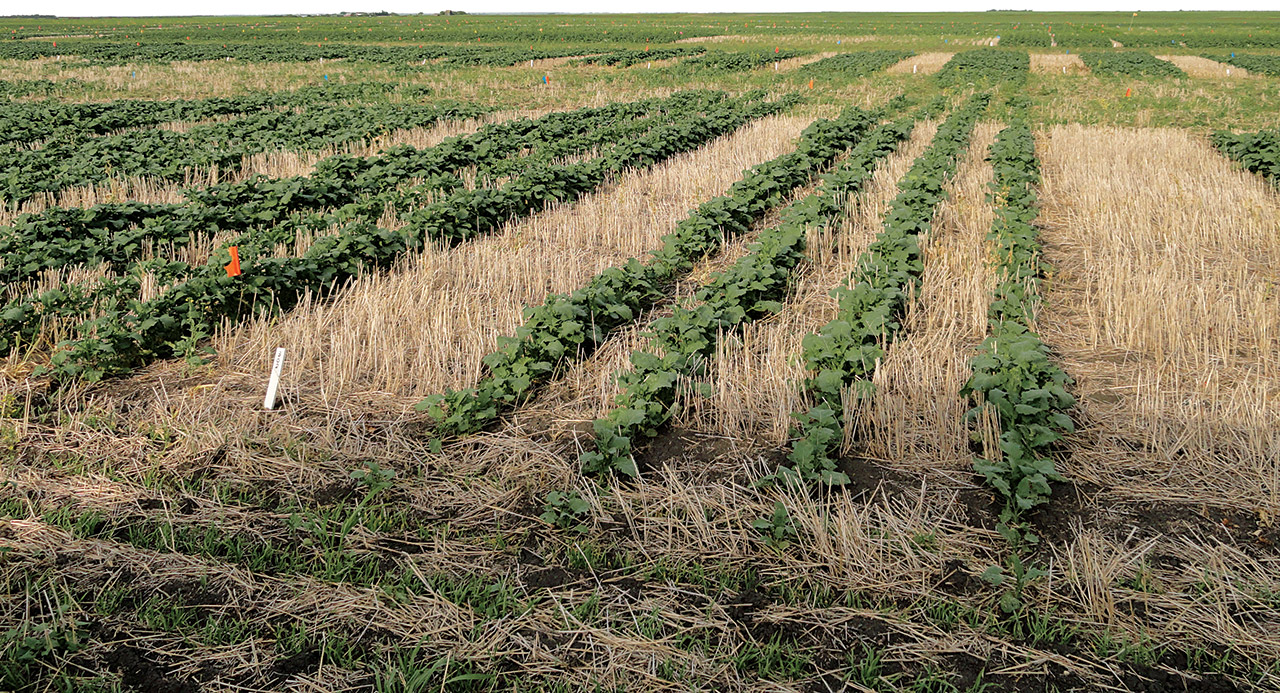Grower-funded research projects
Plant establishment
Response of canola to low plant populations and evaluation of reseeding options
Lead researcher: Anne Kirk, University of Manitoba
Funding: SCDC
Purpose and progress: The purpose is to determine the plant population at which reseeding would be recommended based on the influence of plant population on yield, maturity, seed size and green seed count. Results indicate that hybrid canola compensates for reduced plant stands by increasing branching and podding, however days to maturity and percent green seed increase as plant density decreases. Final results show the minimum plant stand required to achieve 90 percent of the maximum yield was 18 plants per square metre.
Investigating wider row spacing in no-till canola: Implications for weed competition, response to nitrogen fertilizer and seeding rate recommendations
Lead researcher: Chris Holzapfel, Indian Head Agricultural Research Foundation
Funding: SCDC
Purpose and progress: Year 3 of 4. Objectives are to evaluate the perfor-mance of canola at row spacing levels ranging from 25 to 60 cm (10″ to 24″) and to investigate the potential implications of wider row spacing on side-banded nitrogen, seeding rate recommendations and weed competition. So far, under good growing conditions, canola can perform well at row spacing as wide as 60 cm. Preliminary results indicate that nitrogen fertilizer and seeding rate recommenda-tions will be similar regardless of row spacing.
Seeding between the lines: Evaluating the potential of interrow seeding for canola in Southern Alberta
Lead researcher:
Ken Coles, Farming Smarter
Funding: ACPC
Purpose and progress: Year 3 of 3. The purpose is to study the influence of seed row placement in relation to the previous stubble, using enhanced GPS guidance. So far, seeding directly on top of the previous stubble reduces canola plant stand establishment but does not impact yield. Inter-row and check treatments resulted in best seedling survival while disc/hoe openers with independent depth control out-yielded rigid frame shank openers.
Seeding rates for precision seeded canola
Lead researcher: Laryssa Grenkow, Western Applied Research Centre
Funding: SCDC
Purpose and progress: The purpose is to compare seedling uniformity and subsequent yield response of canola seeded with air-seeders equipped with an UltraPro roller versus a traditional Valmar roller across a range of target seeding rates. Differences in seedling uniformity and seed yield between the two rollers are inconsistent among site-years. Conversely, increases in seeding rate to target plant populations above 40 plants per metre squared appear to provide consistent yield increases regardless of roller type.
Verifying seed primer benefits on canola and wheat establishment, vigour and yield under direct seeding in Alberta
Lead researcher: Kabal S. Gill, Smoky Applied Research & Demonstration Association (SARDA)
Funding: ACPC, SARDA
Purpose and progress: During 2013 and 2014, the responses of canola to nine seed primers and of wheat to 10 seed primers were determined in seven site-years. Stand establishment, vigour and yield responses to the tested seed primers were inconsistent.
Identification of superior crop rotations to minimize inputs, optimize crop production and maximize contribution margin
Lead researcher: Kabal S. Gill, SARDA
Funding: ACPC, ABC, SARDA
Purpose and progress: Year 6 of 7. Compared the canola and wheat monocultures with 2 to 3 year crop rotations that also included peas, barley and flax. Results have indicated crop rotation benefits of 10.3 bu./ac. for canola and 7.4 bu./ac. for wheat during the years 2010 to 2013.
Evaluation of winter Brassica rapa for cultivation in Alberta
Lead researcher: Habibur Rahman, University of Alberta
Funding: ACPC, ACIDF
Purpose and progress: Winter B. rapa survived the Canadian winter often (three of four study years) in Lethbridge where winter is generally milder compared to the other locations in Alberta. Crops seeded and grown under retained stubble condition showed better survival compared to bare soils under the tillage condition.
Fertility management
Understanding soil variability for effective zone management in precision agriculture: An evaluation of sensor-based soil mapping
Lead researcher: Ken Coles, Farming Smarter
Funding: ACPC, Farming Smarter
Purpose and progress: Year 3 of 4. This study looks at the usefulness of electro-conductivity sensors for zone delineation in variable rate applications. Both Veris and EM38 sensors are practical tools that can be used to characterize soil variability. However more work and analysis are needed to understand yield response curves associated with this variation. On-farm research trials are proving useful in verifying opportunities with variable rate technologies.
Long-term effects of different soil test based fertilizer rates on crop production, contribution margin, and soil quality in the Peace region
Lead researcher: Kabal S. Gill, SARDA
Funding: ACPC, ABC, APG, SARDA
Purpose and progress: From 2009 to 2012, a canola-barley-field pea-wheat rotation was used to assess the response of crops and fertilizer recommendations to repeated applications of 0, 60, 80, 100, 120, and 140 percent of the soil test N, P, K and S rates. Responses depended on the crop type and growing conditions (mainly rain and temperature) in the season. The N and P fertilizer recommendations for crops changed with the growing conditions (mainly rain and temperature) in the previous season.
Assessing current soil test based fertilizer recommendations for direct seeding systems to optimize crop production and contribution margin
Lead researcher: Kabal S. Gill, SARDA
Funding: ACPC, ABC, SARDA
Purpose and progress: Year 5 of 6. Starting from 2010, cereal (wheat or barley) and canola responses to fertilizer rates (0, 60, 100 and 140 percent of soil test recommendations) were assessed under conventional and direct seeding systems. Crop yields were significantly increased with 60 percent rates while differences between the 60 to 140 percent were not always significant. No consistent interactions were observed between the seeding systems and fertilizer recommendations.
Quantifying the economic and soil quality benefits of long-term no-till using a canola-spring wheat rotation
Lead researcher: Chris Holzapfel, Indian Head Agricultural Research Foundation
Funding: SCDC, ACPC
Purpose and progress: Year 3 of 3. Objectives are to examine the changes occurring in the soil as length of time under no-till increases. The study compares the impact of past and present nitrogen (N) rates on crop N uptake and grain yield at two adjacent sites differing in the length of time under no-till. By comparing yields between the short- and long-term no-till sites over the past 10 years, it was determined that a canola-spring wheat rotation under long-term no-till management provided a substantial economic advantage over short-term no-till, indicating that the soil is continually improving under no-till management.
Long-term residual effects of alternative nitrogen management practices in canola production systems
Lead researcher: Ramona Mohr, AAFC Brandon
Funding: SCDC
Purpose and progress: Year 1 of 2. The purpose is to determine whether using different nitrogen (N) management practices over the course of a four-year canola-wheat rotation will affect N availability in subsequent growing seasons. Nitrogen availability following a crop failure versus a “bumper crop” is also being assessed. So far, researchers have observed some differences in crop growth among treatments, suggesting differences in N availability in the first year after the rotation. However, analysis is underway to confirm these observations and to quantify plant-available N supply.
Canola yield, grain quality and nitrate movement in soils of Northern Alberta as affected by use of different nitrogen sources
Lead researcher: Mackenzie Applied Research Association
Funding: ACPC
Purpose and progress: Year 1 of 5. The purpose is to examine the effects of urea, ESN, Agrotain urea and SuperU on canola yield and oil content. Analysis of yield, chlorophyll concentration index and oil content data had not been completed for year 1 when this magazine when to print. However, germination data did not show any difference.
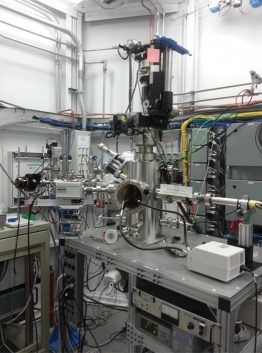
Transformations and fate of seed-placed sulphur fertilizers in Saskatchewan soils
Lead researcher: Jeff Schoenau, University of Saskatchewan
Funding: SCDC, ADF
Purpose and progress: The purpose is to determine the fate of different forms of sulphur fertilizers applied in the seed-row of canola, peas and wheat. So far, researchers have observed that sulphate sources are effective in supplying large amounts of available sulphate in the seed-row after seeding. Gypsum, a slightly soluble sulphate form, is highly effective in supplying available sulphate early in the growth period. Elemental S was least effective. These findings were supported by plant uptake data and synchrotron spectroscopy results on soil samples analyzed at the Canadian Light Source.
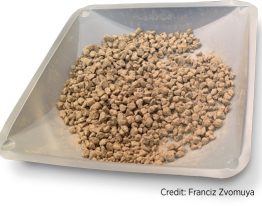
has found that phosphorus-rich struvite (shown in the photo) from hog manure produces similar canola yields to monoammonium phosphate (MAP) and causes less seedling toxicity.
Can slow-release monoammonium phosphate (MAP) and struvite improve phosphorus use efficiency and reduce seedling toxicity in canola?
Lead researcher: Francis Zvomuya, University of Manitoba
Funding: ACPC, SCDC, MCGA
Purpose and progress: Year 2 of 2. The purpose was to compare phosphorus uptake and seedling toxicity from hog manure-recovered struvite and coated MAP versus regular MAP application. Results show that recovered struvite and coated MAP produce similar canola yields to MAP and cause less seedling toxicity than MAP.
Field proofing the use of plant hormones to increase canola, wheat and pea yields
Lead researcher: Jocelyn Ozga, University of Alberta
Funding: ACPC, APG, Agricultural and Food Council, University of Alberta, Syngenta
Purpose and progress: Researchers tested to see if the application of specific auxin-type plant growth regulators (PGRs) to plants could increase seed yield under normal and heat stress conditions during reproductive develop-ment. In greenhouse and field studies, certain cultivars responded to an auxin-type PGR application by increasing seed yield under normal and heat stress conditions during reproductive develop-ment. Yield component data suggested that the auxin application could increase the seed 1,000-kernel weight.
Improving growth and yield of canola with a novel fungal endophyte Piroformospora indica
Lead researcher: Janusz Zwiazek, University of Alberta
Funding: ACPC, AIBIO, WGRF
Purpose and progress: Objectives are to determine the effects of the novel growth-promoting fungus Piriformospora indica on nutrient uptake, stress resistance, growth and yield of canola. So far, canola plants inoculated with the fungus had higher root and shoot fresh weights when exposed to low growth temperature and when subjected to water deficit stress and reduced nitrogen and phosphorus nutrition. Fungal inoculation had no effect when canola plants were subjected to high salinity treatment.
Optimizing variable rate nitrogen fertilizer application in fields with spatial variability
Lead researcher: Doon Pauly, AARD
Funding: ACPC, ACIDF
Purpose and progress: Canola was included in this study as it was part of the co-operators’ rotation. In 2013 there was 1 of 5 sites with canola, but it had extensive hail damage and minimal treatment effects. As a result, limited canola data is available on this project at this time.
Integrated Pest Management
Development and application of rapidly deployable in-field molecular diagnostics for plant diseases
Lead researcher: Tim Dumonceaux, AAFC Saskatoon
Funding: SCDC, ADF
Purpose and progress: Year 1 of 2. The purpose is to develop molecular diagnostics for plant pathogens that are applicable to field-based studies. Target pathogens for initial development are clubroot (Plasmodiophora brassicae), blackleg (Leptosphaeria maculans) and aster yellows (Candidatus Phytoplasma spp). Researchers have developed and partially validated both lab-based (quantitative PCR) and field-based (loop-mediated isothermal DNA amplification) methods for all of these pathogens. The researchers have also developed rapid methods for DNA extraction from insects that may carry Candidatus Phytoplasma spp., and have successfully tested our methods by assaying insects. These preliminary studies have helped determine the needs for more extensive field-based studies planned for 2015.
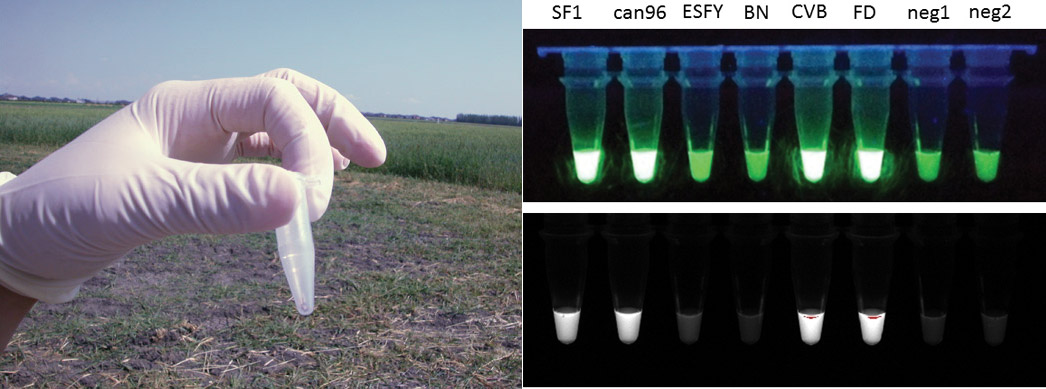 Tim Dumonceaux and his colleagues at AAFC Saskatoon use rapid in-the-field DNA tests to check insects for aster yellows-causing phytoplasma. DNA is extracted from insects and a one-hour molecular test called LAMP (loop-mediated isothermal DNA amplification) is performed on the extracted insect DNA. Samples displaying fluorescence (“glowing” tubes) are positive.
Tim Dumonceaux and his colleagues at AAFC Saskatoon use rapid in-the-field DNA tests to check insects for aster yellows-causing phytoplasma. DNA is extracted from insects and a one-hour molecular test called LAMP (loop-mediated isothermal DNA amplification) is performed on the extracted insect DNA. Samples displaying fluorescence (“glowing” tubes) are positive.
Proof of concept to build a nano and antibody based pathogen specific plant disease monitoring device for agricultural pest management
Lead researcher: Xiujie Li, Alberta Innovates
Funding: ACPC, Alberta Innovates
Purpose and progress: The long-term goal is to develop an in-field sensor for the detection of plant disease pathogen levels for disease prevention. Results indicate a positive correlation, a linear relationship, between the numbers of S. sclerotiorum ascospores and the conductivity of their antibody-spore-gold nanoparticle complex. The study also proved that conductivity measure-ment can detect as few as five ascospores of S. sclerotiorum in the sample. A negative correlation, a linear relationship, was also obtained when Leptosphaeria maculans was used as a pathogen, indicating that the future device could be species-specific and applied to more plant disease pathogens.
Development of canola cultivar blackleg resistance groups: feasibility evaluation
Lead researcher: Ralph Lange, Alberta Innovates
Funding: ACPC, WGRF, ACIDF
Purpose and progress: The objective is to determine if Canadian canola cultivars can be organized into resistance groups that would allow producers to choose cultivars with different blackleg resistance genes from those previously seeded. To date, researchers have adapted the Australian procedure by inducing ascospore formation in the residues. Early indications are that the number of resistance groups in Canada may be limited, so researchers have significantly increased the number of residue collection sites to decrease the chances of missing potential groups. Cultivar testing is proceeding.
Evaluation of the toxicity of the secondary metabolites produced by Leptosphaeria maculans
Lead researcher: Xiujie Li, Alberta Innovates
Funding: ACPC
Purpose and progress: This study found that sirodesmin PL has compar-able toxicity to gliotoxin, however no sirodesmin PL was found in canola products. This includes canola seeds collected from blackleg-infected fields and seeds with very high levels of L. maculans contamination in Alberta. No sirodesmin PL was detected in canola oil or canola meal obtained from processors or retailers in Alberta.
Analysis and monitoring of Leptosphaeria maculans race dynamics in Western Canada for effective use of cultivar resistance in management of blackleg on canola
Lead researcher: Gary Peng,
AAFC Saskatoon
Funding: SCDC, ACPC, ACIDF, WGRF
Purpose and progress: This project intends to provide an up-to-date
L. maculans Avr-gene profile in key canola production regions, monitor fluctuation of Avr-gene frequency in the pathogen population, and identify new virulent races of L. maculans capable of overcoming cultivar resistance promptly when it happens. Profiling L. maculans isolates from Westar trap plots showed that AvrLm1, AvrLm9, and AvrLep2 were completely absent in the pathogen population, while AvrLm3 and AvrLep1 were present at very low levels. This indicates that the resistance genes corresponding to these Avr genes will not be effective against blackleg in Western Canada. In contrast, AvrLm2, AvrLm4, AvrLm6 and AvrLm7 genes were common in the pathogen popula-tion. Commercial fields of R- or MR-rate cultivars with severe blackleg often showed a unique pattern of Avr-gene composition, and the relevance of this pattern to the “resistance breakdown” is being analyzed.
Identifying virulence factors in Leptosphaeria maculans, the causative agent of blackleg disease of canola
Lead researcher: Hossein Borhan, AAFC Saskatoon
Funding: SCDC
Purpose and progress: Year 3 of 3. The main objective is to develop molecular markers for rapid pathotyping of L. maculans races in a field population. Researchers generated markers for all currently known virulence genes as well as virulence genes recently identified by their lab. These markers have been tested in a subset of L. maculans field populations and proved to be highly reliable for rapid race determination.
Mitigating blackleg disease of canola using fungicide strategies
Lead researchers: Dilantha Fernando, University of Manitoba; Gary Peng, AAFC Saskatoon; Ralph Lange, Alberta Innovates
Funding: ACPC, SCDC, MCGA
Purpose and progress: Year 3 of 3. Objectives are to better understand whether fungicides are useful against the blackleg pathogen, and to understand whether isolates of blackleg would become resistant to the chemicals.
The research found an early fungicide application (2 to 4 leaf) may provide
a benefit against blackleg when cultivar resistance is lost or unavailable. QOI fungicides generally reduced disease incidence and severity more effectively than a DMI fungicide. However, the yield improvement was negligible. Although isolates showed variation in sensitivity to the QOI fungicides, more study is required to understand the true resistance of blackleg strains to fungicides.
Blackleg resistance stewardship: Improving our management of host resistance
Lead researcher: Dilantha Fernando, University of Manitoba
Funding: ACPC, SCDC, MCGA
Purpose and progress: Update: Year 3 of 3. The purpose is to better understand the resistance genes available to the blackleg pathogen populations on the Prairies and also the avirulence genes of the pathogen in growers’ fields. The goal is to formulate better blackleg resistance stewardship through the understanding of the R-genes and the avirulence (Avr) genes. The study found that most canola/rapeseed accessions/cultivars carried Rlm3 (65 percent), while the corresponding AvrLm3 was extremely low (3 percent) on the Prairies. This explains the reason for the recent breakdown of resistance in canola fields throughout the Prairies.
Biocontrol of clubroot and blackleg by the endophytic microorganisms of canola
Lead researcher: Paul Holloway, University of Winnipeg
Funding: ACPC, SCDC, MCGA
Purpose and progress: Endophytes are bacteria and fungi that inhabit the tissue of plants without causing any harm and, in fact, they may benefit the plant. Researchers are isolating and identifying plant endophytes that have protective activity against canola pathogens and may in the future be used to suppress canola diseases.
Extent of infestation and potential for eradication of clubroot at sites in Saskatchewan
Lead researcher: Bruce Gossen, AAFC Saskatoon
Funding: SCDC, ADF, WGRF
Purpose and progress: This study assesses the potential for using fumigation to reduce or eliminate the resting spores of Plasmodiophora brassicae (the cause of clubroot) in new infestations and other situations where relatively small volumes of soil need to be treated. Two fumigants had good efficacy against clubroot under controlled conditions, but were less effective in the field. One issue that affects efficacy is that the spores of the pathogen are present at least one metre deep in the soil profile. Other factors that affect pathogen detection and fumigation efficacy are being examined.
Toward a strategy for reducing the spore density and dissemination of clubroot of canola in Alberta
Lead researcher: Sheau-Fang Hwang, AARD
Funding: ACPC, ACIDF, WGRF
Purpose and progress: Year 1 of 4. The purpose is to develop a better understanding of the distribution and dispersal of clubroot and to develop methods to eradicate or reduce newly established infestations both within fields and on a regional basis. Resistant cultivars had very low indices of disease (0 to 6 percent) in most crops, however ID values of up to 20 percent were detected in some crops. In field experiments, susceptible cultivars contributed 2 x 108 spores/gram of soil while resistant cultivars contributed 1.2 x 107 spores/g of soil. Use of Vapam on clubroot-infested land improved crop establishment, plant height and seed production of plants and reduced clubroot severity.
Clubroot soil testing in Manitoba
Lead researcher: Lee Anne Murphy, Pest Surveillance Initiative
Funding: MCGA, MAFRD and AAFC
Purpose and progress: The specialized molecular detection laboratory called the Pest Surveillance Initiative will collect, process and analyze soil samples for the presence of clubroot at very low levels and before plant symptoms are present. A grid sampling program has begun that will sample fields in every township-range in agro-Manitoba to establish a benchmark for clubroot presence.
Effects of clubroot resistant canola lines
Lead researchers: Stephen Strelkov, University of Alberta, and Sheau-Fang Hwang, AARD
Funding organizations: ACPC
Purpose and progress: In a study to determine the effects of resistant cruciferous plants on spore populations, repeated introduction of both susceptible and resistant plants progressively increased spore populations in the soil. Introduction of a susceptible cultivar resulted in greater spore populations, higher disease levels and more root hair infection compared with the resistant cultivar. Project Completed.
Supporting continued development of clubroot resistant canola and early detection of clubroot outbreaks
Lead researcher: Michael Harding, AARD
Funding: ACPC, WGRF, ACIDF
Purpose and progress: Year 2 of 4. Objectives are: (1) to maintain a clubroot nursery in a naturally-infested, irrigated commercial field in Southern Alberta where canola lines and varieties can be evaluated for clubroot resistance; and (2) enhance clubroot surveillance in southern Alberta to allow early detection of new infestations south of Highway 1. At this stage, numerous canola lines, varieties and cultivars display complete resistance to Plasmodiophora brassicae pathotype 5. Additionally, surveillance in commercial canola fields has revealed no new infestations south of Highway 1.
Improving sclerotinia disease control in edible beans and canola
Lead researcher: Michael Harding, AARD
Funding: ACPC, WGRF, APG
Purpose and progress: Year 2 of 4. Objectives are: to screen for synergistic interactions between fungicides and micronutrient ions that improve sclerotinia disease control; and to do field evaluations of plant resistance activators that improve sclerotinia disease control. At this stage, researchers have observed additive and perhaps synergistic antimicrobial activity when silver nitrate, manganese sulfate, zinc sulfate or copper sulfate were combined with one or more of three commercially available fungicides.
Development of a rapid quantitative detection method for sclerotinia stem rot inoculum to aid disease risk assessments and fungicide spray decisions
Lead researcher: Stephen Strelkov, University of Alberta
Funding: SCDC, ACPC, MCGA
Purpose and progress: Final Year. The purpose is to develop and refine a rapid quantitative method for pathogen detection on canola and flower petals. The molecular method has been developed with large numbers of samples collected and tested for sclerotinia in numerous commercial canola fields in the Edmonton region. Various parameters such as seeding date were also monitored and recorded. The large dataset is now being analyzed in order to validate the robustness of the test.
Effects of genetic sclerotinia tolerance, foliar fungicide applications and their interactions on the incidence and severity of sclerotinia stem rot infection in Argentine canola
Lead researcher: Chris Holzapfel, Indian Head Agricultural Research Foundation
Funding: SCDC
Purpose and progress: Year 2 of 3. Objectives are: to evaluate genetic tolerance to sclerotinia stem rot combined with foliar fungicide applications for reducing sclerotinia stem rot infection in canola; and to determine if fungicides may be recommended when growing a resistant cultivar under heavy disease pressure. So far, although sclerotinia levels have been relatively low, researchers have observed lower incidence with a tolerant hybrid and also when foliar fungicides were applied. There have been no cases where yields of a tolerant hybrid were increased with fungicide application or where dual fungicide applications were advantageous over a single application, but these results may differ under more severe disease pressure.
Getting one step closer to sclerotinia control through cultivar resistance and biological applications
Lead researcher: Dilantha Fernando, University of Manitoba
Funding: ACPC, SCDC, MCGA
Purpose and progress: Year 1 of 3. The purpose is to better understand the biological processes associated with the protection of canola against sclerotinia. So far, researchers have observed that large sets of genes are turned on directly at the site of infection in canola leaves in response to sclerotinia infection. Putative targets of the plant defense response pathway have been identified and will be functionally characterized.
Seed treatment as an alternative method to control aster yellows
Lead researchers: Chrystel Olivier and Bob Elliott, AAFC Saskatoon
Funding: AAFC, SCDC, and industry partners
Purpose and progress: Second year. The primary objective is to evaluate the potential of seed treatments as an alternative method to control leafhoppers and suppress aster yellows (AY), using laboratory and field assays. During the first year, an AY rating scale based on specific AY symptoms was developed to measure the frequency and severity of AY disease in canola plants. Other results indicate that, in treated plants, leafhopper mortality and frequency and severity of AY symptoms depend on soil moisture, canola growth stage and the number of leafhoppers per plant. Leafhopper mortality is higher in dry soil as compared to wet soil and consequently, frequency and severity of AY symptoms is higher in wet soil as compared to dry soil.
Aster yellows and swede midge: New threats to Prairie canola production
Lead researchers: Chrystel Olivier and Julie Soroka, AAFC Saskatoon
Funding: ACPC, WGRF, ACIDF
Purpose and progress: Second year. The purpose is to determine the extent of infestation, evaluate yield losses, develop economic thresholds and forecast warnings, and identify resistant canola lines for AY and swede midge.
In 2013, no significant difference in AY severity and incidence was observed between commercially available canola cultivars. Depending on the location, AY infections in leafhoppers were between 10 and 30 percent in 2013 and less than 1 percent in 2014. Swede midge continues to expand its range on the Prairies, with adults, larvae or damage seen west of North Battleford, SK and close to the American border in Manitoba in 2014. Swede midge adults emerged relatively late in 2014, and damage to canola was light. Little variation in swede midge damage was seen among 18 different lines in six different crucifer species. Specimens of a pteromalid wasp were observed parasitizing swede midge larvae in the field, and investigations on the species as a potential biological control were initiated.
Monitoring of swede midge populations in Saskatchewan, and determining the impact of swede midge on different growth stages of canola
Lead researcher: Julie Soroka, AAFC Saskatoon
Funding: SCDC
Purpose and progress: Year 1 of 3. The purpose is to investigate the correlation of swede midge infestation and canola growth stage by determining the effects of early and late seeding on canola seed yields in midge-infested commercial canola fields. Swede midge damage in field plots was light in 2014. Earlier-seeded plots did not suffer less damage than plots seeded two weeks later. Further, none of the seed treat-ments applied for flea beetle control decreased swede midge damage.
Coordinated surveillance, forecasting and risk warning systems for field crop insect pests of the Prairie ecosystem
Lead researcher: Owen Olfert, AAFC Saskatoon
Funding: ACPC, SCDC, MCGA, WGRF
Purpose and progress: Year 1 of 5. The purpose is to develop and implement insect surveillance programs to keep the Canadian agriculture industry informed of the risks to crop production from pest species and to highlight and conserve their natural enemies. So far, sampling protocols have been developed/adapted for large-scale monitoring of a number of the major pests, and spatial analysis techniques have been developed and implemented to forecast their risks to crop production.
Performance and cost of field scouting for weeds and diseases using imagery obtained with an unmanned aerial vehicle
Lead researcher: Christoph Neeser, AARD
Funding: ACPC, AARD, ACIDF, WGRF, APG, AWC, ASCA, PGA
Purpose and progress: Development of small and relatively inexpensive unmanned aerial vehicles (UAVs) has generated much interest in their use as a field-scouting tool. Over the 2014 cropping season images of alfalfa, barley, canola, peas, potatoes and wheat were captured in June, July and August. For ground verification, selected areas were photographed from the ground following the capture of the UAV images. These images have been processed and will be analyzed to determine to what extent they can be used to locate weeds, crop diseases or other problem areas. The final step will consist of a cost benefit analysis of this technology.
Up close and personal
CanoLAB is a one-day concentrated learning experience, with real canola plants and top experts to help you identify symptoms from disease, insect feeding, herbicide carryover, nutrient deficiency, to give just a few examples.
Saskatoon, SK
February 10-11, TCU Place
Olds, AB
February 18-20, Olds College
Brandon, MB
March 11-12, ACC
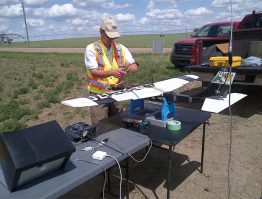
Development and implementation of a weather-based, near real time, crop insect pest monitoring/prediction model and program for Alberta
Lead researcher: Daniel Itenfisu, AARD
Funding: ACPC, AARD
Purpose and progress: The purpose is to develop and implement a provincial weather-based monitoring/prediction model for three economically significant insect pests in Alberta: bertha armyworm, wheat midge and alfalfa weevil. The model will use near real time (NRT) weather data from around 350 stations and provincial pest survey data. In year one, researchers: (1) collected field data relevant to the project and data organization; (2) are reviewing suitable weather-based models and current AARD pest surveillance branch insect pest field survey programs; (3) are designing a portable weather station; (4) produced provincial biweekly preliminary prediction maps for bertha armyworm, wheat midge and alfalfa weevil through the growing season; and (5) are finalizing the hiring of a full time researcher.
Detection, identification and control strategies for management of cutworms (Noctuidae) on the Prairies
Lead researcher: Kevin Floate,
AAFC Lethbridge
Funding: ACPC, SCDC
Purpose and progress: Year 3 of 4. The purpose is to facilitate the control
of cutworms that are pests of canola. Among the results achieved so far, are: (1) development of a molecular-based method to provide quick and accurate identification of key pest species;
(2) surveys of cutworms in Alberta, Saskatchewan and Manitoba;
(3) identification of wasps and flies parasitic on these cutworms;
(4) studies to assess the ability of these parasitoids to attack different species of pest cutworms; and
(5) studies to assess the effect of seed cultivar, seed treatment and fertilizer regime on cutworm development.
Biocontrol of canola cutworms: Identification and attraction of parasitoids
Lead researcher: Barbara Sharanowski, University of Manitoba
Funding: ACPC
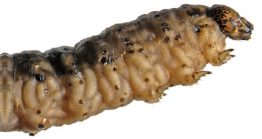
at the University of Manitoba
is looking for parasitoids of cutworms.
This cutworm has been parasitized by
a Copidosoma wasp. Copidosoma are attracted to yellow flowers and odours from plants in the family Brassicaceae.
Purpose and progress: Year 3 of 3. The purpose is to examine the parasitoid community associated with cutworms in canola and investigate cover crops that may improve their efficiency as natural enemies. In addition to identifying several new species of parasitoids previously unknown to attack cutworms, researchers have also shown that the polyembryonic parasitoid Copidosoma cuproviridis is attracted to yellow flowers and odours from plants in the family Brassicaceae. Several cover crops improve longevity in this species, but parasitoid rates remain low in the field. Researchers will examine alternative natural enemies for control, such as entomopathogenic fungi.
Management of lygus bugs and seedpod weevils in canola
Lead researcher: Hector Carcamo, AAFC Lethbridge
Funding: ACPC
Purpose and progress: This four-year study examined the effect of spraying canola at early flower for seedpod weevils on lygus bugs. In most cases, fields sprayed at early flower had fewer lygus bugs at the pod stage. Planting date also had a major effect on insect abundance: early seeded fields had more weevils and fewer lygus at pod than those planted late; late seeded fields had fewer weevils at early flower but more lygus at the pod stage than those planted early. To maximize canola yield potential growers should plant early and manage weevils if they exceed the economic thresholds, but should NOT spray fields where weevils are below threshold to attempt to reduce lygus at the pod stage because other factors such as rain and predators may reduce lygus numbers. Tank-mixing insecticide with fungicide spray in full flower is not recommended for weevils or lygus, and can be harmful to pollinators and natural enemies.
Improving lygus management for current canola and faba bean cultivars
Lead researcher: Hector Carcamo, AAFC Lethbridge
Funding: ACPC, ACIDF, APG
Purpose and progress: Year 3 of 4. Lygus density treatments in the cages at all three sites — Lethbridge, Lacombe and Beaverlodge — seem to have succeeded in creating the variable insect pressures required to validate the thresholds using current hybrid cultivars. Yield and insect data are being processed and preliminary analysis of the first three years will be shared at extension meetings in the winter.
Improving crop risk assessment tools for bertha armyworm
Lead researcher: Scott Meers, AARD
Funding: ACPC
Purpose and progress: This project has reconfirmed the validity of the current bertha armyworm monitoring and forecasting system. Although occasionally populations crash due to disease outbreaks, if the traps are in sufficient density, the pheromone trapping system is very good at identifying areas that are at risk of bertha armyworms at damaging levels.
Reliable and effective use of managed bees for canola pollination
Lead researchers: Shelley Hoover, AARD; Steve Pernal, AAFC Beaverlodge; Ralph Cartar, University of Calgary
Funding: ACPC, SCDC, ACIDF, ASCA, Beekeepers Commission of Alberta
Purpose and progress: Year 1 of 3. The purpose is to quantify the contribu-tion of managed pollinators to canola yield, and to provide management guidelines to maximize both pollination and bee health. Preliminary results indicate that insect visitation of commodity canola flowers tends to decrease with depth into a field, whereas the volume of nectar available to pollinators tends to increase with distance from the field edge.

Night spraying: Pesticide efficacy with nighttime applications
Lead researcher: Ken Coles,
Farming Smarter
Funding: ACPC, Farming Smarter
Purpose and progress: Year 3 of 3. The purpose is to study time of day influences on weed control in pre-seed burndown applications as well as in-crop applications in Liberty and glyphosate tolerant canola, and in peas and wheat. Differing environmental conditions within a 24-hour period can significantly influence weed control. Mid-day application timing resulted in the best overall control in pre-seed applications and with Liberty and glyphosate tolerant canola. Nighttime applications were best for peas and worst for Liberty canola. Wheat herbicides performed the best in all conditions.
Emergence timing and management of cleavers in Saskatchewan canola crops
Lead researcher: Christian Willenborg, University of Saskatchewan
Funding: SCDC, ADF
Purpose and progress: Emergence timing of cleavers varies by population and most populations exhibit some level of spring and fall emergence. This study will work on differentiating speciation within the cleavers populations. Preliminary data also suggests that two unregistered herbicides, in combination with in-crop recommended herbicides for each herbicide tolerant system, provide good control of cleavers. Registration of these herbicides could come within a couple of years.
Glyphosate-resistant kochia survey in Saskatchewan
Lead researcher: Hugh Beckie,
AAFC Saskatoon
Funding: SCDC
Purpose and progress: A stratified-randomized survey of 342 sites in southern and central regions of Saskatchewan and 283 sites in southern Manitoba was conducted in the fall of 2013. Screening confirmed 17 glyphosate-resistant (GR) kochia populations in nine municipalities in west-central or central Saskatchewan, and two GR populations from different municipalities in the Red River Valley of Manitoba.
Can harvest weed seed management be used to control kochia, cleavers and wild buckwheat?
Lead researcher: Steve Shirtliffe, University of Saskatchewan
Funding: ACPC, SCDC, MCGA
Purpose and progress: The purpose is to determine when weed seeds are shed relative to the maturity of canola. This will determine which weeds are candidates for pre-harvest herbicides or harvest weed seed management.
Biology and management of glyphosate-resistant kochia
Lead researcher: Bob Blackshaw, AAFC
Funding: ACPC, AWC, ABC, ACIDF, WGRF
Purpose and progress: Year 2 of 3. The purpose is to identify cost-effective alternative herbicides to control glyphosate-resistant kochia in pre-seed, chemfallow, in-crop, and post-harvest applications. Additionally, studies examining timing of seed maturity and seed dormancy will allow more optimal herbicide timing and aid in developing integrated management strategies.
So far, several unregistered herbicides show potential to control glyphosate-resistant kochia and this information have been conveyed to the respective crop protection companies.
Harvest Management
Quantifying potential canola yield loss due to shattering and pod drop amongst high-yielding Brassica napus cultivars
Lead researcher: Chris Holzapfel, Indian Head Agriculture Research Foundation
Funding: SCDC
Purpose and progress: Year 4 of 4. Objectives are to quantify environmental yield losses due to pod shatter and pod drop amongst a variety of modern canola hybrids and a wide range of environments. So far, while differences in seed losses are frequently observed, they are not always consistent from one site to the next and environmental conditions (i.e. weather, disease) are typically the most important determining factors affecting the magnitude of seed losses in standing, mature canola. While losses due to pod drop tend to be relatively minor when canola is straight-combined at an optimal stage, they become increasingly significant as straight-combining is delayed and can sometimes exceed shattering losses.
Developing a rapid method to evaluate pod-drop in canola
Lead researcher: Rob Gulden, University of Manitoba
Funding: ACPC, SCDC
Purpose and progress: Year 2 of 3. The purpose is to refine and validate pod retention resistance measurements as a new and rapid method of estimating pod-drop in canola. So far, the method performs consistently across a number of genotypes and environments. Researchers are refining the number of measurements and the position on the plant from which these measurements should be obtained to best estimate pod-drop among these genotypes.
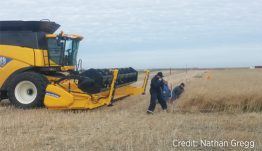
Summer storage of canola
Lead researcher: Joy Agnew, Prairie Agricultural Machinery Institute (PAMI)
Funding: SCDC, ACPC, MCGA, CCC
Purpose and progress: Year 1 of 1. The purpose is to evaluate best management practices for summer storage of canola. So far, all three treatments (no management, turning the bin, aerating the bin) resulted in safe storage of dry canola throughout the summer months.
Canola direct-cut harvest system development
Lead researcher: Nathan Gregg, PAMI
Funding: SCDC, ADF, WGRF, PAMI
Purpose and progress: Year 1 of 3. The purpose is to compare header types for straight combining canola, looking for the optimal system. Yield, seed quality, header shatter loss, and environmental shatter loss are compared for draper, rigid and extendable cutterbar headers as well as a swath-based system.
The study will also compare results for standard hybrids and hybrids with pod shatter resistance. Data is being processed from year one.
Genetics
Development of a germplasm resource to dissect complex traits in Brassica napus
Lead researcher: Isobel Parkin, AAFC Saskatoon/University of Saskatchewan
Funding: SCDC, ADF, ACPC and industry partners
Purpose and progress: Year 2 of 4. The purpose is to broaden the genetic pool available for canola breeding, capturing diversity from all available collections of annual B. napus. The project will also provide the tools for rapidly introducing valuable variation into cultivar development. Excellent progress has been made. Highly diverse founder lines were selected and the first three generations are completed with the final lines scheduled to be ready in the spring of 2015. Extensive phenotyping of the founder lines is ongoing in both the field and lab, which has identified interesting variations for multiple traits including stress resistance and seed quality.
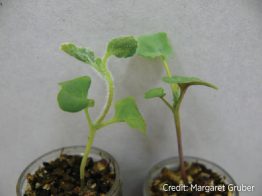
Final phase research to improve ‘hairy canola’ trait in Brassica napus
Lead researcher: Margaret Gruber, AAFC Saskatoon
Funding: SCDC, ADF
Purpose and progress: Year 3 of 4. The purpose is to develop new canola tester lines with modified expression of individual trichome (hair) genes in an effort to develop trichome-rich germplasm with resistance to the crucifer flea beetle and seedling drought. Researchers have a number of new GMO lines, and are now testing several genes for potential to develop a non-GMO hairy canola line.
Molecular cytogenics of blackleg resistance in the Brassica B-genome and introgression of resistance into B napus through recurrent backcrossing
Lead researcher: Habibur Rahman, University of Alberta
Funding: ACPC, ACIDF
Purpose and progress: The project has identified the chromosomal location of one of the B-genome resistance genes. Identification of the other B-genome resistance genes and introgression in canola is in progress.
Studies on the genetic and molecular basis for clubroot resistance in canola
Lead researcher: Stephen Strelkov, University of Alberta
Funding: SCDC, ACPC
Purpose and progress: Final Year. The aim is to help build durable clubroot resistance by increasing understanding of major resistance genes, developing molecular markers, and investigating the biological function of host and pathogen genes differentially expressed during the infection process. The research has shown that resistance to pathotype 3 in selected host populations is under monogenic control, and has identified molecular markers linked to a clubroot resistance gene in spring canola. It has also shown that while most plants are resistant to most pathogens, P. brassicae uses primary infection to overcome this general type of resistance, which allows the disease to progress when secondary zoospores attack.
Characterization and utilization of newly identified resistance sources for sustainable clubroot control on canola
Lead researcher: Gary Peng,
AAFC Saskatoon
Funding: SCDC
Purpose and progress: This project builds on prior identification of diverse clubroot resistance (CR) sources, and focuses on characterizing CR genes in the resistance genotypes identified in order to provide the industry with new sources of resistance. Between labs at AAFC Saskatoon, University of Alberta and University of Manitoba, progress during the first year includes identifying three CR genes, evaluating a three-way cross involving a clubroot resistant rutabaga line and two spring canola lines in field plots, and mapping eight loci from different B. rapa materials.
Genomics of clubroot disease development in canola and development of in-plant RNAi to impart novel resistance
Lead researcher: Peta Bonham-Smith, University of Saskatchewan
Funding: SCDC, ADF
Purpose and progress: Ten thousand full-length cDNAs have been isolated and sequenced from a library of canola root gall tissues. Of these, 7,000 sequences have been analyzed and annotated against the NCBI database; 2,730 cDNAs are from the Plasmodiophora brassicae pathogen and 2,590 cDNAs are from the infected canola. Researchers are currently identifying the P. brassicae secretome and possible pathogen effectors associated with the infectious stage(s) of the pathogen. They are also reviewing plant sequence data to identify changes in the expression of plant genes/pathways responsible for, or as a result of, infection and disease. First generation (T1) transgenic Arabidopsis plants (model system for canola) carrying single and double RNAi constructs (with P. brassicae sequences) have been produced and are currently being screened for successful T2 lines. Once homozygous T3 lines are isolated they will be challenged with the pathogen.
Using non-host species to identify novel genes for durable clubroot resistance in canola
Lead researcher: Peta Bonham-Smith, University of Saskatchewan
Funding: SCDC, ADF
Purpose and progress: The purpose is to explore a different genetic resource, a non-host species, such as the small grass Brachypodium distachyon to identify genes that can confer durable, broad-spectrum resistance to Plasmodiophora brassicae, the pathogen responsible for clubroot. So far, researchers have confirmed that B. distachyon can be infected with P. brassicae but, similar to wheat and winter rye, it is a non-host and does not develop clubroot.
Developing near-isogenic Brassica napus lines for differentiating pathotypes of Plasmodiophora brassicae
Lead researcher: Fengqun Yu,
AAFC Saskatoon
Funding: SCDC, ADF, WGRF
Purpose and progress: Year 1 of 4. The purpose is to develop Brassica napus lines, each with a single unique clubroot resistance gene from Brassica vegetable species. These lines could be used for differentiating pathotypes of P. brassicae and rapid incorporation into canola variety development programs. So far, researchers have obtained all donor resistant lines and initiated introgression of clubroot resistance genes into a B. napus cultivar.
Identification and mapping of clubroot resistance genes in Brassica and development of SNP markers tightly linked to resistance genes
Lead researcher: Fengqun Yu, AAFC Saskatoon
Funding: ACPC, WGRF
Purpose and progress: Year 2 of 3. The purpose is to identify clubroot resistance genes in Brassica rapa and develop molecular markers for rapid introgression of the clubroot resistance into canola. So far, researchers have identified two clubroot resistance genes and developed more than ten SNP markers tightly linked to one of the genes. These markers are available to the Canadian canola industry for rapid incorporation into their canola variety development programs.
Building durable resistance to clubroot disease in canola: Identification of multiple clubroot resistance genes from Brassica napus and B. rapa for marker-assisted gene stacking in canola breeding
Lead researcher: Gopalan Selvaraj, National Research Centre, Saskatoon
Funding: SCDC
Purpose and progress: This collabo-rative effort with Rahman’s group at the University of Alberta has identified a resistance locus in Brassica napus and has further determined genome-wide transcriptional dynamics in cohorts of susceptible and resistant lines of B. napus arising from genetic segregation.
Improving the Ogura CMS hybrid system and establishing heterotic gene pools for hybrid breeding in canola Brassica juncea
Lead researcher: Bifang Cheng, AAFC Saskatoon
Funding: SCDC
Purpose and progress: Objectives are: (1) to develop a fully functional Ogura hybrid system in canola B. juncea; and (2) to establish heterotic gene pools for use in development of high-yielding hybrids. Researchers successfully developed the improved B. juncea homozygous R line VR441 (RfoRfo) via molecular marker-assisted selection in combination with the increased recombination frequencies involving the Rfo gene in resynthesized B. juncea. Development of VR441 has made the Ogura CMS hybrid system fully functional in this species.





